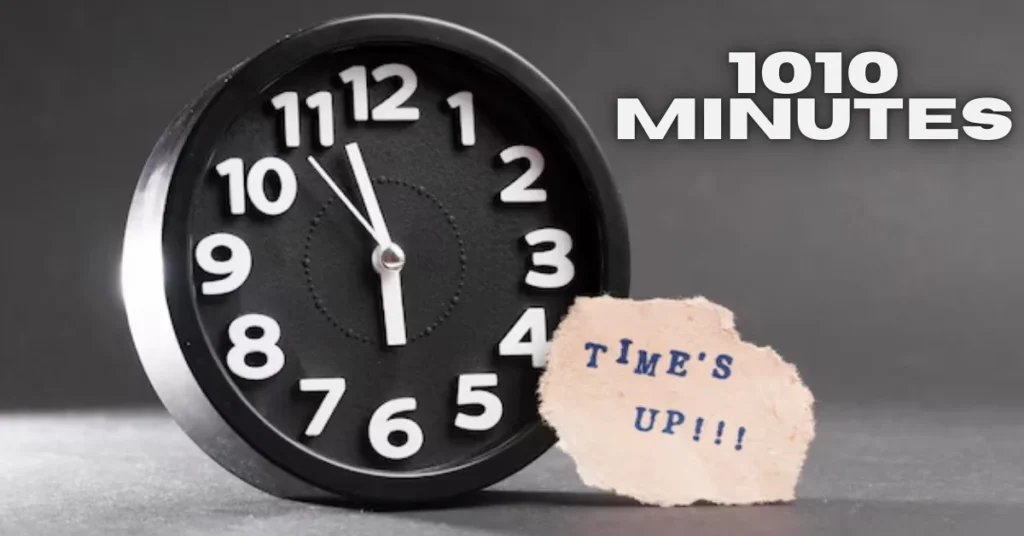Time is an essential part of our lives. We rely on it to schedule our days, plan events, and manage our activities. Yet, have you ever stopped to consider how we measure time? Most people are familiar with the traditional system of hours and minutes, but there’s a fascinating alternative that’s gaining traction: 1010 minutes.
What exactly does 1010 minutes mean? How does it fit into the broader concept of time measurement? This guide will take you through everything you need to know about this unique method. From its roots in decimal time to practical applications in everyday life, get ready to explore a fresh perspective on how we perceive and utilize time!
Understanding Time Measurement
Time measurement has evolved over centuries, transforming the way we organize our lives. Early civilizations relied on natural phenomena like the sun and moon to track time. Days were divided into segments based on daylight and darkness.
As societies advanced, more precise methods emerged. The invention of mechanical clocks brought a new level of accuracy. Minutes and seconds became standard units, allowing for synchronized activities across communities.
In modern times, we’ve adopted the 24-hour clock system widely used around the globe. Yet this conventional approach isn’t without its quirks—like leap years or varying lengths of months.
Despite its prevalence, some argue that traditional timekeeping is cumbersome. This opens doors for innovative concepts like decimal time systems that can streamline how we think about hours and minutes altogether. Understanding these different methods is crucial as we explore alternatives such as 1010 minutes in today’s fast-paced world.
The Basics of 60 Minutes
The concept of 60 minutes is a fundamental building block in our understanding of time. It represents one hour, a unit we often take for granted.
Each minute consists of 60 seconds. This division dates back to ancient civilizations that recognized the need to measure time accurately.
Sixty minutes can feel fleeting or stretched, depending on what you’re doing. A thrilling movie might pass quickly, while waiting in line for coffee feels eternal.
Using this system allows us to synchronize activities and coordinate schedules with precision. From setting alarms to planning meetings, the structure helps maintain order in our daily lives.
Despite its simplicity, this measurement has profound implications on productivity and lifestyle management. Understanding how these moments accumulate can significantly impact how we value our time.
The Introduction of Decimal Time
Decimal time, a revolutionary concept, emerged from the desire to simplify how we measure moments. Unlike traditional systems that divide hours into 60 minutes and minutes into 60 seconds, decimal time proposes a straightforward approach.
In this system, the day is divided into ten equal parts. Each part represents what we traditionally understand as one hour but reimagined within a new framework. The simplicity of this division holds appeal for those seeking clarity in scheduling.
This idea gained traction during the French Revolution when reformers aimed to create a more rational society. They believed decimal time could eliminate confusion and standardize daily life. However, while innovative, it faced challenges in widespread adoption due to ingrained habits tied to conventional timekeeping methods.
The pursuit of practicality continues today as some explore how decimal structures can coexist with our established routines without causing disruption or confusion.
The Creation of 1010 Minutes
The concept of 1010 minutes emerged as a response to the limitations of traditional timekeeping. It reimagines how we measure and perceive time in our daily lives.
This innovative system divides hours into decimals, allowing for easier calculations and conversions. Instead of clinging to the standard sixty-minute hour, 1010 minutes introduces a more fluid approach.
Developed by forward-thinking individuals seeking simplicity, this model aims to streamline scheduling and improve productivity. By adopting decimalization, it aligns with other modern systems that rely on base ten.
Proponents argue that this shift can enhance communication around time management in various fields—be it business or personal endeavors. As society evolves technologically, so too does our understanding of fundamental concepts like time measurement.
How 1010 Minutes Works in Comparison to Traditional Time Systems
1010 minutes introduces a fresh perspective on measuring time. Unlike traditional systems that rely on hours and minutes, this method simplifies everything into a decimal format.
In the 1010 system, one day is divided into 10 equal parts. Each part corresponds to 101 minutes. This structure eliminates the complexities of seconds and varying hour lengths found in standard timekeeping.
For example, when you say “3.5” in 1010 minutes, it’s straightforward: halfway through the fourth segment of the day. In contrast, converting this to hours can be cumbersome for many people.
This approach aims to enhance clarity and ease of understanding for daily activities and scheduling. With its uniformity, users may find themselves better equipped to manage their time efficiently without getting lost in conversions or calculations related to conventional systems.
Benefits and Uses of 1010 Minutes
The concept of 1010 minutes offers intriguing benefits for both individuals and businesses. By breaking time into a decimal system, it simplifies calculations. This can be particularly useful in industries that rely on precise timing, like manufacturing or event planning.
Using 1010 minutes enhances productivity. It allows for easier scheduling by creating uniformity across tasks. Instead of converting hours and minutes, professionals can work with straightforward decimals.
Another advantage is clarity in communication. When everyone understands the same time format, confusion diminishes significantly during meetings or projects.
Furthermore, adopting this method opens up avenues for innovative educational approaches. Schools could use 1010 minutes to teach students about alternative mathematical systems and their practical applications.
Flexibility becomes key as well; people can adapt their routines using this modern approach to time management without feeling constrained by traditional methods.
Implementing 1010 Minutes in Daily Life
Embracing 1010 minutes in daily life can be both refreshing and practical. Imagine planning your day around this unique time structure. Instead of traditional hours, segments of ten represent a new way to approach tasks.
Start with simple adjustments. For instance, allocate 1010 minutes for focused work sessions. This method encourages productivity without the fatigue associated with longer blocks of time.
Incorporate it into your scheduling apps or physical planners. Label each segment clearly and stick to your plan as much as possible. You might find that organizing activities becomes more intuitive over time.
Social interactions can also benefit from this approach. Suggest meeting durations based on 1010-minute intervals—quick coffee breaks become breezier yet meaningful catch-ups instead of lengthy discussions.
As you experiment, share your experiences with friends or colleagues who may express curiosity about adopting this innovative system themselves.
Challenges and Criticisms of 1010 Minutes
Despite its innovative approach, 1010 minutes faces several challenges. One major concern is the lack of widespread understanding. Many people are accustomed to traditional time systems and find it difficult to adapt.
Another criticism revolves around practicality. In fast-paced environments, switching between standard hours and the 1010-minute format can lead to confusion. This could hinder communication in both professional and personal settings.
Moreover, cultural resistance plays a significant role. Timekeeping methods have deep-rooted historical significance for many cultures. The introduction of decimal time may be viewed as unnecessary or disruptive by those who value tradition.
There’s skepticism about efficiency. While proponents argue that 1010 minutes simplifies calculations, others believe it complicates daily routines without substantial benefits. These issues highlight the hurdles that this system must overcome before gaining acceptance widely.
Conclusion
As we’ve explored, the concept of 1010 minutes offers a fresh perspective on time measurement. It challenges our traditional views rooted in the 60-minute hour and introduces a more straightforward decimal system. This innovative approach allows us to think about time differently.
By breaking down hours into smaller, easily digestible units, it provides potential benefits for scheduling and productivity. The simplicity of 1010 minutes can make planning easier for individuals and organizations alike.
Yet, as with any new idea, there are hurdles to overcome. Resistance from those accustomed to conventional systems is natural. Adopting such changes requires education and effort.
Whether you see it as an intriguing alternative or merely a novel concept, understanding 1010 minutes enriches your knowledge about how we perceive time itself. It invites reflection on how we organize our lives daily while encouraging openness toward innovation in even the simplest aspects of existence.
FAQs
What is “1010 minutes”?
1010 minutes is a decimal time concept that divides a day into 10 equal parts, with each part representing 101 minutes, offering a simplified approach to time measurement.
How does 1010 minutes compare to traditional time systems?
Unlike traditional systems that use hours and minutes, 1010 minutes simplifies calculations by using a decimal format, making scheduling and time management more intuitive.
What are the benefits of using 1010 minutes?
Benefits include easier scheduling, enhanced productivity, and clearer communication in both personal and professional settings, especially in industries that require precise timing.
Can 1010 minutes be implemented in daily life?
Yes, individuals can start by allocating 1010-minute intervals for tasks, integrating this system into scheduling apps or planners for a more streamlined approach to managing their time.
What challenges does 1010 minutes face in gaining acceptance?
Challenges include widespread unfamiliarity, potential confusion in switching between systems, and cultural resistance to moving away from traditional timekeeping methods.







